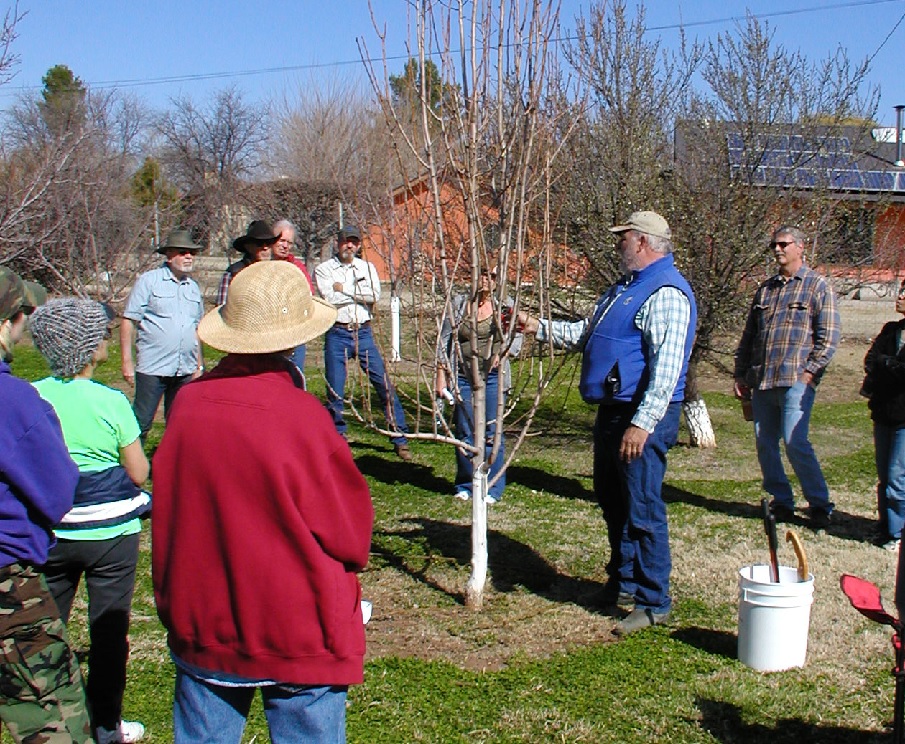 Deciduous Fruit Tree Pruning - January 24, 2018 Jeff Schalau, Agent, Agriculture & Natural Resources University of Arizona Cooperative Extension, Yavapai County Deciduous fruit trees benefit from yearly pruning throughout their productive lifespan. However, it is difficult to describe the pruning process in writing. Each tree has individual characteristics that make it nearly impossible to generalize. In addition, there are multiple approaches, most of which are valid and dependent on individual preferences. I’ll do my best to provide theoretical information in the remainder of the column, and then invite you to the free pruning demonstrations that I conduct each year. At these demonstrations, you can watch and ask questions as we discuss the principles of deciduous fruit tree pruning. Pruning is critical to maintaining deciduous fruit tree health and productivity. Pruning also creates a desirable structure for supporting the fruit crop and can keep the tree a more manageable size. That being said, no pruning should occur without good reasons to do so. Winter pruning often causes a tree to respond vigorously, often too vigorously, when large limbs are removed. Conversely, summer pruning does not cause as drastic a growth response and is often used to remove selected branches without initiating as much regrowth. Some fruit growers prefer trees that are trained to a “central leader”. This strategy is most often used with apples and pears and requires removal of selected branches from the trunk while leaving behind strategically spaced side branches (called scaffold branches). Conversely, “open-center” pruning removes the central leader at a very young age (preferably right after planting) to develop a tree that spreads outward from the trunk allowing light to penetrate and air to circulate in the center of the tree. Open-center pruning is often used for stone fruits (peaches, nectarines, plums, and apricots). I also prune my apple trees to an open center which keeps them smaller and easier to harvest. All trees, whether fruit or ornamental, should be pruned to remove crossing and inwardly growing branches. Dead and diseased wood should also be removed. Sometimes fruit trees have been neglected and require extensive pruning. In these cases, I recommend addressing the most crucial problems first and leaving the less important issues for summer or next year. As a general rule, you should not remove more than one-quarter to one-third of the live canopy in any given year. More than this can be removed from younger peach and nectarine trees due to their vigorous growth and tendency to die back when branches are too dense. Most apples and pears produce fruit on spurs: shortened twigs where flowers are produced. These spurs usually become productive at 3 and can continue 10 or more years. Plums, apricots, and cherries produce fruit on shorter-lived spurs. Peaches and nectarines produce fruit predominantly on the previous year’s wood. This is critical when planning your pruning strategy for each of these species. In general, peaches and nectarines should be pruned more aggressively than the others to produce the desired quantity and quality of fruit bearing wood for the following year. Large pruning cuts should be kept to a minimum. These cuts take longer to heal and will often cause water sprouts (vigorous vegetative shoots) to grow in that vicinity during the following growing season. If you must make large cuts, do not use a pruning sealant to cover the wound. Simply allow the cut surface to callous over naturally. Finally, use only clean, sharp pruning tools. Soak the loppers and hand pruners in rubbing alcohol (or an antibacterial/antiviral disinfectant solution) for 5 to 10 minutes between trees and especially after pruning diseased material. Four years ago, some Master Gardener volunteers and I created four YouTube videos that describe and demonstrate deciduous fruit tree pruning principles and techniques. There is also a short video discussing pruning tools, sanitation, and safety. These are available online at: cals.arizona.edu/yavapai/pruning/videos.html. Now, I’d like to invite you to attend one of my fruit tree pruning demonstrations. I will be conducting these at: the Marmaduke Orchard, 3435 S Silver Rd, Camp Verde (off Salt Mine Rd) on Saturday February 10th from 10 am to noon and at the McLandress Orchard, 850 S. Maricopa in Chino Valley on Saturday February 24th from 10 AM to noon. For maps and directions to these demonstrations, visit the Yavapai County Cooperative Extension Web Site at: cals.arizona.edu/yavapai/pruning. I will also post notice of any workshop cancellations due to weather on my Twitter feed (@jeffschalau). Follow the Backyard Gardener on Twitter – use the link on the BYG website. If you have other gardening questions, call the Master Gardener help line in the Camp Verde office at 928-554-8992 or e-mail us at verdevalleymg@gmail.com and be sure to include your name, address and phone number. Find past Backyard Gardener columns or provide feedback at the Backyard Gardener web site: http://cals.arizona.edu/yavapai/anr/hort/byg/. Photos  Past deciduous fruit tree pruning workshop, Camp Verde.
Past deciduous fruit tree pruning workshop, Camp Verde.Additional Resources Backyard Fruit Production at Elevations 3500 to 6000 Feet (Updated 2015) University of Arizona Cooperative Extension extension.arizona.edu/sites/extension.arizona.edu/files/pubs/az1162-2015.pdf |